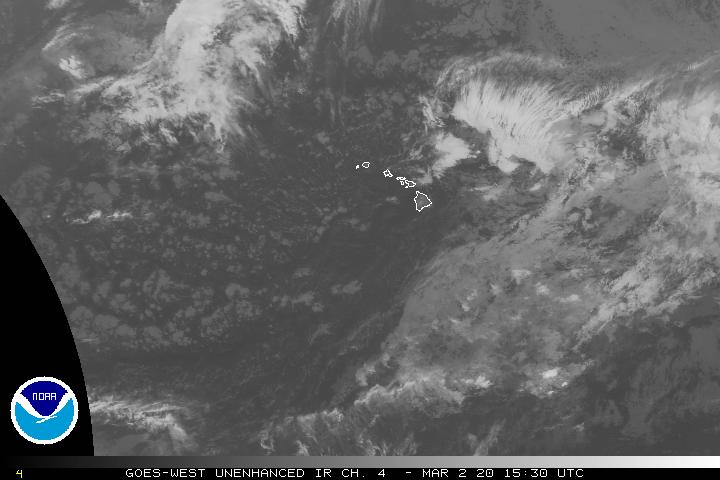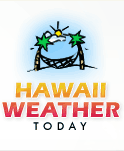Air Temperatures – The following high temperatures (F) were recorded across the state of Hawaii Saturday…along with the low temperatures Saturday:
74 – 70 Lihue, Kauai
80 – 75 Honolulu, Oahu
74 – 70 Molokai
76 – 72 Kahului AP, Maui
83 – 76 Kailua Kona
78 – 68 Hilo AP, Hawaii
Here are the latest 24-hour precipitation totals (inches) for each of the islands as of Saturday evening:
1.30 Kilohana, Kauai
0.90 Manoa Lyon Arboretum, Oahu
3.70 Molokai
0.07 Lanai
0.05 Kahoolawe
7.27 Puu Kukui, Maui
13.30 Pahoa, Big Island
The following numbers represent the strongest wind gusts (mph) as of Saturday evening:
30 Lihue, Kauai
37 Kuaokala, Oahu
35 Molokai
43 Lanai
27 Kahoolawe
33 Maalaea Bay, Maui
38 Waikoloa, Big Island
Hawaii’s Mountains – Here’s a link to the live webcam on the summit of our tallest mountain Mauna Kea (nearly 13,800 feet high) on the Big Island of Hawaii. This webcam is available during the daylight hours here in the islands, and at night whenever there’s a big moon shining down. Also, at night you will be able to see the stars — and the sunrise and sunset too — depending upon weather conditions.
Aloha Paragraphs

High pressure north-northeast…cold front far northwest and east

Deep moisture offshore from the state…especially to the south

Partly to mostly cloudy…clearing from the west

Showers mostly windward and mountains…and offshore
Looping image
Small Craft Advisory…strong trade winds and rough seas over all coastal and channel waters
Wind Advisory…strong trade winds Lanai, and north and east Kohala
High Surf Advisory…east shores of Kauai, Oahu, Molokai, Maui, and the Big Island
~~~ Hawaii Weather Narrative ~~~
Broad Brush Overview: High pressure north of the state will keep locally windy trades blowing this weekend. Unsettled weather will continue due to deep tropical moisture, and an upper trough in the vicinity of the islands, although gradually improving conditions are expected as the weekend progresses. The trade winds will ease Monday as a cold front approaches from the northwest. The front along with its showers will move southward through the island chain Monday night and Tuesday…followed by strong north to northeast winds. Cooler, drier and pleasant conditions are expected for the middle and latter part of next week.
Details: Deep moisture will slowly decrease today and tonight as the upper level troughing shifts southward through the islands. As a result, we should see wet trades across the entire island chain this morning, with conditions improving over the Kauai and Oahu this afternoon, while remaining rather wet over Maui County and the Big Island. Conditions will further improve over the western islands tonight, with shower coverage also diminishing over Maui County and to a lesser extent across the Big Island. Improved weather is expected statewide Sunday, as upper level ridging builds southward helping to stabilize conditions across the island chain. Shower coverage will remain highest over the Big Island Sunday morning, with fairly dry conditions expected statewide by Sunday afternoon.
Looking Ahead: A cold front will approach from the northwest Sunday night and Monday, easing the trade winds across the island chain. The front is expected to move southward through the western islands Monday night and through the rest of the state Tuesday. Strong north-northeasterly winds are expected to build in behind the front. These strong winds should occur for a relatively brief period however, as high pressure will quickly settle southward toward the state Tuesday night and Wednesday, then over or just to the north of the islands Thursday through Friday. As a result, light to moderate trades on Wednesday will become light statewide Thursday through Friday. In the wake of the frontal passage, look for very dry conditions, along with cooler temperatures, lower humidity and plenty of sunshine Wednesday right through Friday. Finally, we could see another cold front arriving towards next weekend.
Here’s a wind profile of the Pacific Ocean – Closer view of the islands / Here’s the vog forecast animation / Here’s the latest weather map
Marine environment details: Rough boating conditions will continue through the weekend due to a combination of strong trades, and a slowly lowering north-northwest swell. The small craft advisory has been extended through Sunday. Model guidance suggests the local winds will temporarily relax and shift more northerly Monday as a cold front approaches and moves into the area from the northwest. Strong northerly winds, however, will quickly across across the waters in the wake of this front Monday night through Tuesday…then relax through mid-week as a ridge builds over the islands.
The north-northwest swell that peaked over the past couple of days will continue to lower this weekend. Surf associated with this source along exposed north and west facing shores will respond and trend down.
The latest surface analysis supports a northwest building during the new week. This source will become reinforced Monday night through mid-week.
Surf along exposed north and west facing shores associated with this active pattern could near advisory levels again Monday, then potentially reach warning levels Tuesday through mid-week as the reinforcing northerly swell and strong northerly winds fill in behind the cold front.
Large surf associated with this northerly swell, coinciding with strong northerly winds, peak monthly tides, and beach erosion from recent large surf events could translate to some overwash onto vulnerable roadways Monday night through Wednesday. The best chance for overwash will be centered around the early morning high tide cycles Tuesday through Wednesday (prior to daybreak).
Surf along east facing shores will remain rough this weekend due to the strong trades. Additionally, a reinforcing northeast swell will likely keep the surf elevated along east facing shores early in the new week as the winds shift north.
Surf along south facing shores will come up slightly through the weekend due to low pressure that tracked south-southeast of New Zealand last weekend. A similar source will be possible by mid-week.

World-wide Tropical Cyclone activity
>>> Here’s the Saturday PDC Weather Wall Presentation, covering Tropical Cyclone 03B, Tropical Cyclone 01S, and a tropical disturbance being referred to as Invest 93W
>>> Here’s the last PDC Weather Wall Presentation with the 2017 hurricane season summary…covering the Atlantic Ocean, the Caribbean Sea, and the Gulf of Mexico
![]()
>>> Atlantic Ocean:
>>> Caribbean Sea:
>>> Gulf of Mexico:
Here’s a satellite image of the Caribbean Sea…and the Gulf of Mexico
Here’s the link to the National Hurricane Center (NHC)
The 2017 Atlantic hurricane season has ended. Routine issuance of the NHC Tropical Weather Outlook will resume on June 1, 2017. During the off-season, Special Tropical Weather Outlooks will be issued as conditions warrant. The PDC will begin issuing its Tropical Cyclone Activity Reports for the Atlantic Ocean, the Caribbean Sea, and the Gulf of Mexico on June 1st, 2018 as well.
The 2017 Atlantic hurricane season was an extremely destructive season, featuring 17 named storms, tying it with 1936 as the fifth-most active season since records began in 1851, and the most since 2012. The season also the highest number of major hurricanes since the 2005 season. All ten of the season’s hurricanes occurred in a row, the greatest number of consecutive hurricanes in the satellite era. In addition, it was by far the costliest season on record, with a preliminary total of over $368.66 billion (USD) in damages, which is more than double the cost of 2005’s total, and nearly all of which was due to three of the season’s major hurricanes — Harvey, Irma, and Maria. This season is also one of only six years on record to feature multiple Category 5 hurricanes, and only the second to feature two hurricanes making landfall at that intensity.
>>> Eastern Pacific:
Here’s a wide satellite image that covers the entire area between Mexico, out through the central Pacific…to the International Dateline.
Here’s the link to the National Hurricane Center (NHC)
>>> Central Pacific:
Here’s a link to the Central Pacific Hurricane Center (CPHC)
The 2017 Eastern Pacific hurricane season has ended. Routine issuance of the NHC Tropical Weather Outlook will resume on May 15, 2018 for the Eastern Pacific. During the off-season, Special Tropical Weather Outlooks will be issued as conditions warrant. The PDC will begin issuing its Tropical Cyclone Activity Reports for the Eastern Pacific on the 15th of May, 2018.
The 2017 Central Pacific hurricane season has ended. Routine issuance of the NHC Tropical Weather Outlook will resume on June 1st, 2018. During the off-season, Special Tropical Weather Outlooks will be issued as conditions warrant. The PDC will begin issuing its Tropical Cyclone Activity Reports for the Central Pacific on the 1st of June, 2018 as well.
The 2017 Pacific hurricane season was a fairly active Pacific hurricane season, featuring eighteen named storms, nine hurricanes, and four intense hurricanes. The season officially started on May 15 in the eastern Pacific, and on June 1 in the central Pacific…they both ended on November 30. These dates conventionally delimit the period of each year when most tropical cyclones form in the basin. However, the formation of tropical cyclones is possible at any time of the year. This was demonstrated when the first storm, Tropical Storm Adrian, was named on May 10, and became the earliest-known tropical storm in the East Pacific since the advent of satellite imagery. For the third year in a row, the season featured above average activity in July, however, the season was the first to see no tropical cyclones form in the Central Pacific basin since 2012.
>>> Northwest Pacific Ocean: No active tropical cyclones
>>> North and South Indian Oceans / Arabian Sea:
Tropical Cyclone 03B (Ockhi) remains active, here’s a track map, satellite image…and what the computer models are showing
Tropical Cyclone 01S (Dahlia) is now active, here’s a track map, satellite image…and what the computer models are showing
Here’s a link to the Joint Typhoon Warning Center (JTWC)
Interesting: Supermoon 2017: When and How to See December’s ‘Full Cold Moon’ – When the “Full Cold Moon” rises on Sunday night (December 3). It will also be the first (and last) “supermoon” of 2017.
Supermoons happen when a full moon approximately coincides with the moon’s perigee, or a point in its orbit at which it is closest to Earth. This makes the moon appear up to 14 percent larger and 30 percent brighter than usual.
The moon becomes totally full at 5:47am HST on Sunday (December 3). It will officially reach perigee the next day at 10:45pm HST, when it is 222,135 miles away from Earth.
What is a supermoon?
While the moon’s average distance is 238,000 miles from Earth, its orbit isn’t perfectly circular, so that distance varies a small amount. When it reaches apogee, or its farthest distance from Earth, on December 19, it will be 252,651 miles away. That’s a difference of 30,516 miles — but the moon’s distance from Earth can vary more than that.
The perigee for December’s supermoon won’t even be the closest this year, that happened May 25, when the not-so-super new moon was 221,958 miles away from Earth. That date didn’t coincide with a full moon, though, so it didn’t qualify as a supermoon.
Supermoons don’t happen every month because the moon’s orbit changes orientation as the Earth goes around the sun. So, the long axis of the moon’s elliptical path around the Earth points in different directions, meaning that a full (or new) moon won’t always happen at apogee or perigee.
The best time to see a supermoon is just after sunset. Something called the “moon illusion” makes the moon appear even bigger: The closer it is to the horizon, the larger it looks. No one knows exactly why this happens, but it is probably has something to do with our eyes.
More than just the supermoon
The coming weeks are set to dazzle stargazers with some spectacular celestial events. Be sure to head for clear skies for the Geminid meteor shower on December 14, which will fill the sky with up to 120 meteors per hour. We may have been starved of supermoons in 2017, but January 2018 will offer two. Spot the Wolf Moon on January 2, and a rare, “blue” supermoon on January 31.












 Email Glenn James:
Email Glenn James:
David Adam Says:
Pray tell… What..is a “Wolf Moon”…nothing to do with Lon Chaney I hope…Think I’ll chk out that Gemini Shower from Saddle Rd or up from Kiluea Military Camp.. there’s a nice spot at about 8,000′..I think it’s a bit blustery Mauna Kea way…pretty, but not for this island boy…Alohas and Wish you and Yours a Beautiful and Wonder filled Holiday Season….may your days be Bright with Light.. It’s always good to see how so many are more of good nature during this time..Let hope it’s this way for the world in totality,we can sure use some really good will and energy to make life better for all. Man’kind’ needs to get his priorities in order with the goal of LIFE getting the care it needs to flourish and thrive…May the weather always be sunny in heartville.
~~~ Hi David, thanks for this latest comment of yours…from down on the Big Island. Thanks for always thinking the best of folks around the world.
Aloha, Glenn